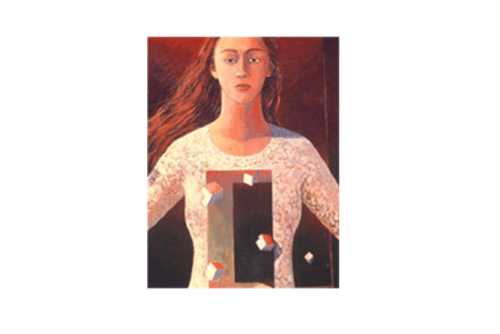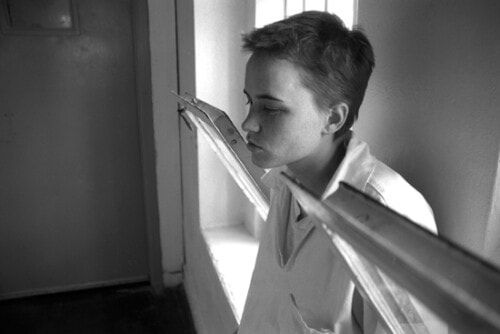I stopped looking for roots and heroes and heroines and I found my peers.
—Ntozake Shange, lost in language & sound
In Shange’s work, music serves as the conduit for spiritual and political longings. The notes fly free; the music invokes the ancestors. Throughout her oeuvre, music, indeed, all of black art, from Bearden’s collages to Diane McIntyre’s choreography, provides a map, a route to, a way OUT, but also a meditative way into the self. This is a notion of the arts that Shange inherits from the Black Arts Movement. This is also the power of Shange’s literature: the sheer beauty, seriousness, playfulness, momentum, and mobility of her writing also honor the ancestors—first by acknowledging their suffering and their beauty, and then by daring to imagine freedom for her own and future generations.
But freedom and music are not only parts of the plot; not only do they provide some of the content, they provide the basis of the form as well. While much has been written about the jazz-like structure of novels like Morrison’s Jazz or Ellison’s Invisible Man, few have looked at the formal qualities of Shange’s prose for structures and feelings most often associated with music. (Her poems, however, are read in this way.) In the space that remains, I want to turn to the formal qualities of Shange’s writing.
It was all interconnected . . . I’d listen to the music and hear what they were saying at the same time, so I was always integrating the two things . . . I’d do my homework, writing things, listening to Cuban rhythms and Brazilian rhythms. I think that accounts for some of my ability to work musically with language. 14
There are three elements of Shange’s writing worth considering in this regard: the look of the words on the page, spelling and syntax, and rhythm. The experience of reading Shange’s work—whether poetry or prose—is always rhythmic, dancelike. Significantly, for a writer who became one of the faces of black feminism in the late 1970s and early 1980s, Shange has always claimed Amiri Baraka and Ishmael Reed as among her greatest literary influences. Known for her lowercase letters and slashes, Shange attributes these devices to the influence of Baraka’s The Dead Lecturer and The System of Dante’s Hell and Ishmael Reed’s Yellow Book Radio. (She was influenced by their syntax and structure, not by their content.) She says she selects lowercase letters because she likes “the ideas that letters dance, not just that words dance.” The look on the page is also an effort to make her own reading of her work more interesting, while at the same time making it more challenging for those of us who read the work—we have to engage with it, move with it, even as we are moved along by it. Simply on a visual level—the way the words look on the page—Shange’s writing dances. She is also known for “odd” spelling, so that you becomes ya, with becomes wit: She spells them as she hears them. As the characters speak to her, she hears the musicality of their speech, and she has to invent a notation system to represent them. Just as the sounds of black music have not always fit within the Western musical system of notation, the English language, the King’s English, the words available to her cannot always represent the sounds of the spoken word or their full meaning.
From the look that influences the way we read the line to the spelling and the phonetic, we might add the rhythm underneath. To read Shange’s work is a rhythmic and lyrical experience. She has written about this element:
I’ll hear very peculiar rhythms underneath whatever I’m typing, and this rhythm affects the structure. For instance, if I’m hearing a rumba, you’ll get a poem that looks like a rumba on the page. 15
We probably have to hear Shange read her own work or listen to an actor who has been given the stage instruction “Rumba-like” in order to hear what she is describing here. Shange doesn’t seem to privilege music-making over writing; instead, she sees them as part of the same process—a process of being grounded in rhythm, of attending to the notes of the spoken word. In one poem, she even includes time signatures and opens each stanza with a treble or bass clef. Throughout her work, she makes explicit the implied relationship between music and poetry, between musician and poet, between the shared artistry of sound and word.
Ntozake Shange’s body of work offers an invitation to enter into the dynamic, multidimensional world of black art. Her creative project is one that informs and teaches all who accept her invitation, and it guides us through a whirlwind of color, sound, movement, and meaning. To partake of her artistic generosity is to be initiated into a community that creates the world anew upon each reading.
- Jessie Hamlin, “Ntozake Shange Weaves tapestries of poetry, music, dance in her serch for love’s meaning,” San Francisco Chronicle 17 Feb. 2006.[↑]
- Maria V. Johnson. “Shange and Her Three Sisters ‘Sing a Liberation Song’: Variations on the Orphic Theme” Black Orpheus: Music in African American Fiction from the Harlem Renaissance to Toni Morrison, ed. Simawe Saadi (New York, Garland Publishing, 2003) 197.[↑]



